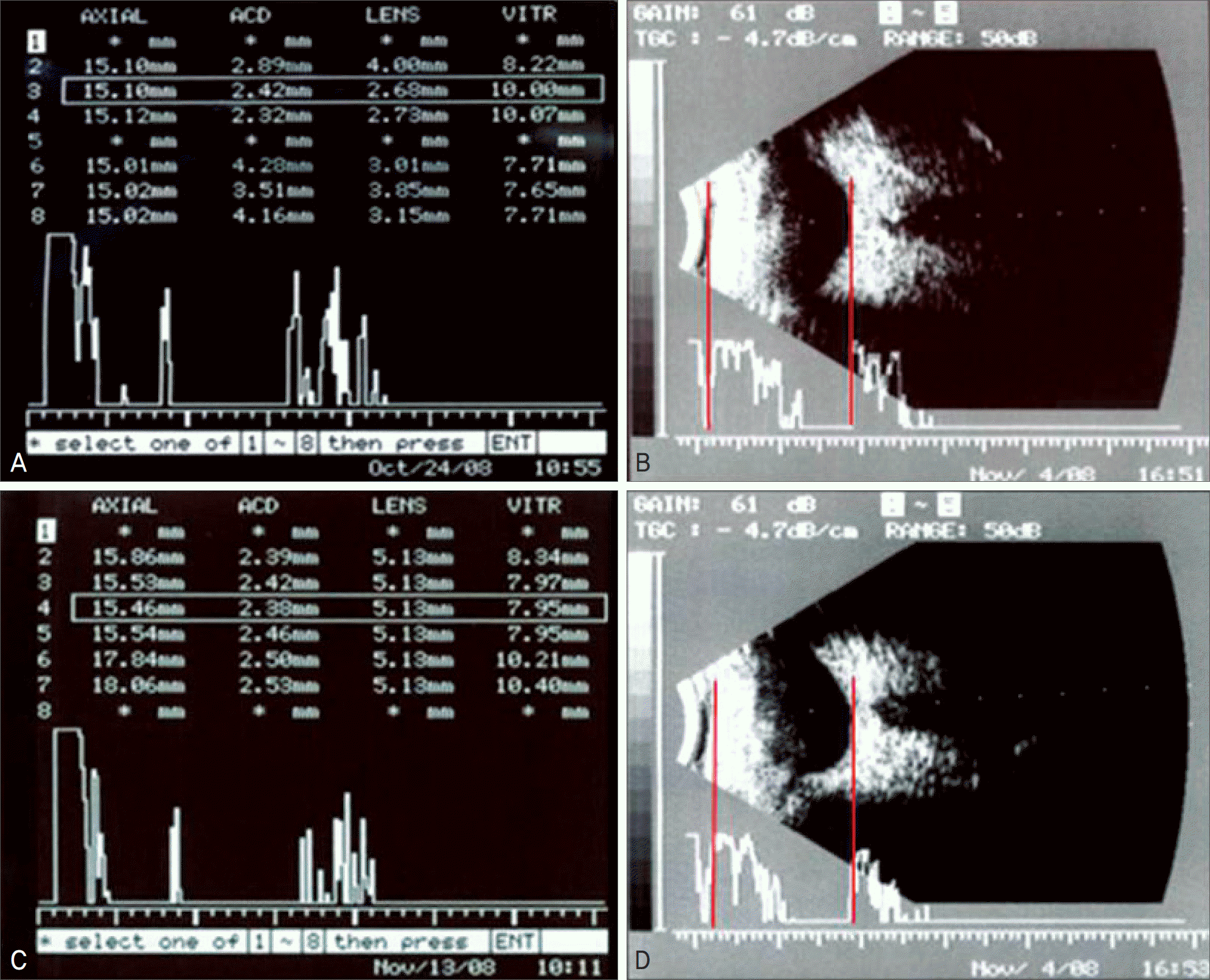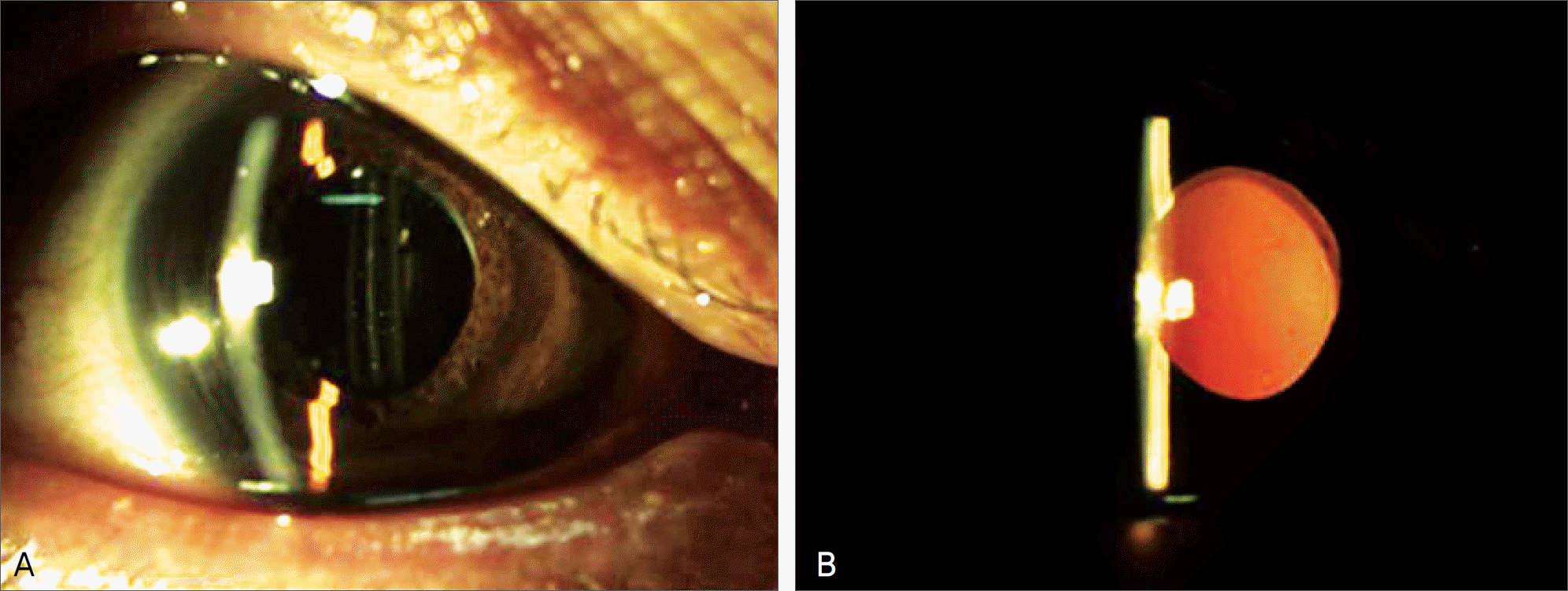Abstract
Purpose
To report a case of cataract surgery using a piggyback method in a patient with pure nanophthalmos with an axial length under 16.00 mm in both eyes.
Case summary
The authors performed cataract surgery using a piggyback method inserting two intraocular lenses (IOLs) in a 44-year-old male with nanophthalmos with axial lengths of OD 15.36 mm, and OS 15.59 mm. Primary implantation of two IOLs of +53.0D as calculated by the SRK/T and Holladay formula was performed in the right eye using a piggyback method. In the left eye, two IOLs of +60.0D calculated by the Hoffer Q formula were implanted. Postoperative hyperopic refractive errors oc-curred in both eyes. The differences between the preoperative target spherical equivalent (SE) and the postoperative one year four month SE were 9.68D in the right eye and 1.63D in the left eye.
Conclusions
Due to high diopter IOL requirements in nanophthalmic patients (less than 16.00 mm) during cataract surgery, the refractive errors were well corrected, without complications, by using a piggyback method. In the present case study, the Hoffer Q formula produced better results than did the SRK/T or Holladay formula in reducing the difference in preoperative and post-operative SEs, but more surgical cases and research are required to establish the most appropriate formula for cataract surgery in nanophthalmos.
Go to : 
References
1. Weiss AH, Kousseff BG, Ross EA, Longbottom J. Simple micro-phthalmos. Arch Ophthalmol. 1989; 107:1625–30.

2. Auffarth GU, Blum M, Faller U, et al. Relative anterior micro-phthalmos: morphometric analysis and its implications for cataract surgery. Ophthalmology. 2000; 107:1555–60.

3. Khairallah M, Messaoud R, Zaouali S, et al. Posterior segment changes associated with posterior microphthalmos. Ophthalmology. 2002; 109:569–74.

4. Wladis EJ, Gewirtz MB, Guo S. Cataract surgery in the small adult eye. Survey Ophthalmol. 2006; 51:153–61.

5. Lee JH, Shin SW, Shin HH. Microphthalmos with large cyst and colo-bomatous microphthalmos in the other eye. J Korean Ophthalmol Soc. 1993; 34:1203–7.
6. Weiss AH, Kousseff BG, Ross EA, Longbottom J. Complex micro- phthalmols. Arch Ophthalmol. 1989; 107:1619–24.
7. Wu W, Dawson DG, Sugar A, et al. Cataract surgery in patients with nanophthalmos: results and complications. J Cataract Refract Surg. 2004; 30:584–90.
9. Gayton JL, Sanders VN. Implanting two posterior chamber intra-ocular lenses in a case of microphthalmos. J Cataract Refract Surg. 1993; 19:776–7.

10. Shugar JK, Lewis C, Lee A. Implantation of multiple foldable acrylic posterior chamber lenses in the capsular bag for high hyperopia. J Cataract Refract Surg. 1996; 22:1368–72.

12. Cao KY, Sit M, Braga-Mele R. Primary piggyback implantation of 3 intraocular lenses in nanophthalmos. J Cataract Refract Surg. 2007; 33:727–30.

13. Chylack LT, Wolfe JK, Singer DM, et al. The lens opacities classification system III. The longitudinal study of cataract study group. Arch Ophthalmol. 1993; 111:831–6.
14. Retzlaff JA, Sanders DR, Kraff MC. Development of the SRK/T intraocular lens implant power calculation formula. J Cataract Refract Surg. 1990; 16:333–40.

15. Holladay JT, Prager TC, Chandler TY, et al. A three-part system for re-fining intraocular lens power calculations. J Cataract Refract Surg. 1988; 14:17–24.

16. Hoffer KJ. The Hoffer Q formula: a comparison of theoretic and re-gression formulas. J Cataract Refract Surg. 1993; 19:700–12.

17. Oshika T, Imamura A, Amano S, et al. Piggyback foldable intraocular lens implantation in patients with microphthalmos. J Cataract Refract Surg. 2001; 27:841–4.

18. Drews RC. Reliability of lens implant power formulas in hyperopes and myopes. Ophthalmic Surg. 1988; 19:11–5.

19. Holladay JT, Gills JP, Leidlein J, Cherchio M. Achieving emmetropia in extremely short eyes with two piggyback posterior chamber intra-ocular lenses. Ophthalmology. 1996; 103:1118–23.

20. Inatomi M, Ishii K, Koide R, et al. Intraocular lens power calculation for microphthalmos. J Cataract Refract Surg. 1997; 23:1208–12.

21. Park JW, Lim SJ, Kim HB. Clinical results of cataract operations using piggyback method. J Korean Ophthalmol Soc. 2001; 42:1500–3.
22. Findl O, Menapace R, Rainer G, Georgopoulos M. Contact zone of piggyback acrylic intraocular lenses. J Cataract Refract Surg. 1999; 25:860–2.

23. Jin JC, Anderson DR. Laser and unsutured sclerotomy in nanophthalmos. Am J Ophthalmol. 1990; 109:575–80.

24. Shugar JK, Schwartz T. Interpseudophakos Elschnig pearls associated with hyperopic shift: a complication of piggyback posterior chamber intraocular lens implantation. J Cataract Refract Surg. 1999; 25:863–7.
25. Gayton JL, Apple DJ, Peng Q, et al. Interlenticular opacification: clinicopathological correlation of a complication of posterior chamber piggyback intraocular lenses. J Cataract Refract Surg. 2000; 26:330–6.

26. Shugar JK, Keeler S. Interpseudophakos intraocular lens surface opa-cification as a late complication of piggyback acrylic posterior chamber lens implantation. J Cataract Refract Surg. 2000; 26:448–55.

27. Fenzl RE, Gills JP, Cherchio M. Refractive and visual outcome of hyperopic cataract cases operated on before and after implementation of the Holiday II formula. Ophthalmology. 1998; 105:1759–64.
28. Choi SH, Chung TY, Chung ES. Refractive change and complications following single or temporary piggyback intraocular lens implantation in infancy. J Korean Ophthalmol Soc. 2005; 46:636–42.
Go to : 
 | Figure 1.A and B-scan (measured by US-3000® (NIDEK, Japan)) image showing the axial lengths of the nanophthalmos patient (A and B: OD, C and D: OS) |
 | Figure 2.Slit lamp photography at post-op 1year 4months (A: Shows 2 well-placed IOLs in the capsular bag. B: Posterior capsular opacity or interlenticular opacity were not observed upon retroillumination.) |
Table 1.
IOL power calculation* and the difference between predicted target and actual postoperative refraction
| Eye | OD | OS |
|---|---|---|
| Axial length (mm) | 15.36 | 15.59 |
| Keratometry reading (D†) | 49.20@177°/51.06@87° | 49.63@3°/52.08@93° |
| Formula | SRK/T | Hoffer Q |
| Target refraction (D) | +0.07 | +0.10 |
| IOL power (D) | 53.0 | 62.0 |
| Actual IOL power (D) (anterior+posterior) | 53.0 (30+23) | 60.0 (30+30) |
|
Refraction at pre-op (D) (Sphere (D) / Cylinder (D) / Axis(°)) |
+16.0 / −2.50 / 180 | +14.0 / −2.50 / 20 |
| Spherical equivalent at pre-op (D) | +14.75 | +12.75 |
|
Refraction at post-op 1 month (D) (Sphere (D) / Cylinder (D) / Axis (°)) |
+10.75 / −2.25 / 5 | +4.00 / −3.00 / 30 |
| Spherical equivalent at post-op 1 month (D) | +9.63 | +2.50 |
| Difference of predicted target refraction and post-op 1 month refraction (∆D‡) | 9.56 | 1.00 |
|
Refraction at post-op 1 year 4months (D) (Sphere (D) / Cylinder (D) / Axis (°)) |
+10.50 / −1.50 / 7 | +4.75 / −3.25 / 20 |
| Spherical equivalent at post-op 1 year 4 months (D) | +9.75 | +3.13 |
|
Difference of predicted target refraction and post-op 1 year 4 months refraction (∆D) |
9.68 | 1.63 |
Table 2.
| Axial length (mm) | SRK/T | Holladay | Hoffer Q | Holladay‡ IOL power +10% of IOL power (D) | |||
|---|---|---|---|---|---|---|---|
| IOL power (D†) | Target refraction (D) | IOL power (D) | Target refraction (D) | IOL power (D) | Target refraction (D) | ||
| 20.50 | 24.5 | 0.03 | 23.5 | 0.14 | 24.0 | 0.20 | 25.85 |
| 20.00 | 26.5 | 0.12 | 25.5 | 0.04 | 27.0 | −0.10 | 28.05 |
| 19.50 | 29.0 | −0.06 | 28.0 | −0.04 | 29.5 | 0.10 | 30.8 |
| 19.00 | 31.5 | −0.17 | 30.5 | −0.04 | 32.5 | 0.10 | 33.55 |
| 18.50 | 33/5 | 0.15 | 33.0 | 0.05 | 36.0 | 0.00 | 36.3 |
| 18.00 | 36.5 | −0.14 | 36.0 | −0.12 | 39.5 | 0.10 | 39.6 |
| 17.50 | 39.0 | 0.03 | 39.0 | −0.17 | 43.5 | 0.10 | 42.9 |
| 17.00 | 42.0 | −0.05 | 42.0 | −0.10 | 48.0 | 0.00 | 46.2 |
| 16.50 | 45.0 | 0.00 | 45.0 | 0.12 | 52.5 | 0.20 | 49.5 |
| 16.00 | 48.5 | −0.17 | 48.5 | 0.13 | 58.0 | −0.10 | 53.35 |
| 15.50 | 51.5 | 0.18 | 52.5 | −0.06 | 63.5 | 0.00 | 57.75 |
| 15.00 | 55.5 | −0.03 | 56.5 | −0.04 | 69.5 | 0.10 | 62.15 |
1. All three formulas present bigger increments of IOL power as axial length decreases. Moreover, Hoffer Q16 formula presents far greater increments above other formulas.




 PDF
PDF ePub
ePub Citation
Citation Print
Print


 XML Download
XML Download